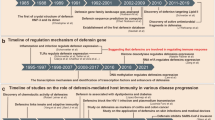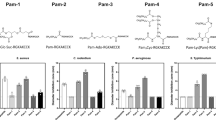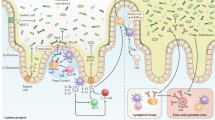Abstract
Defensins are endogenous antibiotics with microbicidal activity against Gram-negative and Gram-positive bacteria, fungi, viruses and protozoa. In the gastrointestinal tract, defensins help regulate the composition and number of colonizing microbes, and protect the host from food-borne and water-borne pathogens. In health, the normal host relationship with the commensal luminal microbiota is beneficial, but the same commensal bacteria could have a pathogenic role in inflammatory diseases. A disturbance in antimicrobial defense, as provided by Paneth cells of the small intestine, seems to be a critical factor in the pathogenesis of ileal Crohn's disease, an inflammatory disease of the intestinal tract. The disruption of the critical balance between antimicrobial peptides and luminal bacteria might also explain other gastrointestinal infections and diseases. Elucidating the underlying mechanisms involved in the regulation and biology of defensins could open up new therapeutic avenues.
This is a preview of subscription content, access via your institution
Access options
Subscribe to this journal
Receive 12 print issues and online access
$209.00 per year
only $17.42 per issue
Buy this article
- Purchase on Springer Link
- Instant access to full article PDF
Prices may be subject to local taxes which are calculated during checkout



Similar content being viewed by others
References
Boman HG (1995) Peptide antibiotics and their role in innate immunity. Annu Rev Immunol 13: 61–92
Zasloff M (2002) Antimicrobial peptides of multicellular organisms. Nature 415: 389–395
Ganz T (2003) Defensins: antimicrobial peptides of innate immunity. Nat Rev Immunol 3: 710–720
Dommett R et al. (2005) Innate immune defence in the human gastrointestinal tract. Mol Immunol 42: 903–912
Wehkamp J et al. (2005) Defensin deficiency, intestinal microbes, and the clinical phenotypes of Crohn's disease. J Leukoc Biol 77: 460–465
Lehrer RI et al. (1993) Defensins: antimicrobial and cytotoxic peptides of mammalian cells. Annu Rev Immunol 11: 105–128
Lehrer RI et al. (2004) Defensins and other antimicrobial peptides. In Mucosal Immunology, 95–110 (Eds Mestecky J et al.) New York: Academic Press
Ouellette AJ et al. (1994) Mouse Paneth cell defensins: primary structures and antibacterial activities of numerous cryptdin isoforms. Infect Immun 62: 5040–5047
Porter EM et al. (1997) Broad-spectrum antimicrobial activity of human intestinal defensin 5. Infect Immun 65: 2396–2401
Ghosh D et al. (2002) Paneth cell trypsin is the processing enzyme for human defensin-5. Nat Immunol 3: 583–590
Ericksen B et al. (2005) Antibacterial activity and specificity of the six human α-defensins. Antimicrob Agents Chemother 49: 269–275
Valore EV et al. (1998) Human beta-defensin-1: an antimicrobial peptide of urogenital tissues. J Clin Invest 101: 1633–1642
Harder J et al. (1997) A peptide antibiotic from human skin. Nature 387: 861
Harder J et al. (2000) Mucoid Pseudomonas aeruginosa, TNF-alpha, and IL-1beta, but not IL-6, induce human beta-defensin-2 in respiratory epithelia. Am J Respir Cell Mol Biol 22: 714–721
Harder J et al. (2001) Isolation and characterization of human beta-defensin-3, a novel human inducible peptide antibiotic. J Biol Chem 276: 5707–5713
Lin PW et al. (2004) Paneth cell cryptdins act in vitro as apical paracrine regulators of the innate inflammatory response. J Biol Chem 279: 19902–19907
Merlin D et al. (2001) Cryptdin-3 induces novel apical conductance(s) in Cl- secretory, including cystic fibrosis, epithelia. Am J Physiol Cell Physiol 280: C296–C302
Yang D et al. (1999) Beta-defensins: linking innate and adaptive immunity through dendritic and T cell CCR6. Science 286: 525–528
Yang D et al. (2001) The role of mammalian antimicrobial peptides and proteins in awakening of innate host defenses and adaptive immunity. Cell Mol Life Sci 58: 978–989
Simon GL and Gorbach SL (1995) Normal alimentary tract microflora. In Infections of the Gastrointestinal Tract, 53–69 (Eds Blaser MJ et al.) New York: Raven Press
McCracken VJ and Lorenz RG (2001) The gastrointestinal ecosystem: a precarious alliance among epithelium, immunity and microbiota. Cell Microbiol 3: 1–11
Bevins CL (2004) The Paneth cell and the innate immune response. Curr Opin Gastroenterol 20: 572–580
Ayabe T et al. (2000) Secretion of microbicidal alpha-defensins by intestinal Paneth cells in response to bacteria. Nat Immunol 1: 113–118
Wilson CL et al. (1999) Regulation of intestinal alpha-defensin activation by the metalloproteinase matrilysin in innate host defense. Science 286: 113–117
Salzman NH et al. (2003) Protection against enteric salmonellosis in transgenic mice expressing a human intestinal defensin. Nature 422: 522–526
Peschel A (2002) How do bacteria resist human antimicrobial peptides? Trends Microbiol 10: 179–186
Salzman NH et al. (2003) Enteric salmonella infection inhibits Paneth cell antimicrobial peptide expression. Infect Immun 71: 1109–1115
Islam DF et al. (2001) Downregulation of bactericidal peptides in enteric infections: a novel immune escape mechanism with bacterial DNA as a potential regulator. Nat Med 7: 180–185
Zaalouk TK et al. (2004) Differential regulation of beta-defensin gene expression during Cryptosporidium parvum infection. Infect Immun 72: 2772–2779
Hornef MW et al. (2002) Bacterial strategies for overcoming host innate and adaptive immune responses. Nat Immunol 3: 1033–1040
O'Neil DA et al. (1999) Expression and regulation of the human b-defensins hBD-1 and hBD-2 in intestinal epithelium. J Immunol 163: 6718–6724
Cunliffe RN et al. (2001) Human defensin 5 is stored in precursor form in normal Paneth cells and is expressed by some villous epithelial cells and by metaplastic Paneth cells in the colon in inflammatory bowel disease. Gut 48: 176–185
Salzman NH et al. (1998) Enteric defensin expression in necrotizing enterocolitis. Pediatr Res 44: 20–26
Wehkamp J et al. (2003) Defensin pattern in chronic gastritis: HBD-2 is differentially expressed with respect to Helicobacter pylori status. J Clin Pathol 56: 352–357
Shen B et al. (2005) Human defensin 5 expression in intestinal metaplasia of the upper gastrointestinal tract. J Clin Pathol 58: 687–694
Kamal M et al. (2001) Mucosal responses to infection with Trichinella spiralis in mice. Parasite 8 (Suppl 2): S110–S113
Marshall BJ et al. (1985) Pyloric Campylobacter infection and gastroduodenal disease. Med J Aust 142: 439–444
Wada A et al. (1999) Induction of human beta-defensin-2 mRNA expression by Helicobacter pylori in human gastric cell line MKN45 cells on cag pathogenicity island. Biochem Biophys Res Commun 263: 770–774
Hamanaka YF et al. (2001) Expression of human beta-defensin 2 (hBD-2) in Helicobacter pylori gastritis: antibacterial effect of hBD-2 against Helicobacter pylori. Gut 49: 481–487
Bajaj-Elliott M et al. (2002) Modulation of host antimicrobial peptide (beta-defensins 1 and 2) expression during gastritis. Gut 51: 356–361
Uehara N et al. (2003) Human beta-defensin-2 induction in Helicobacter pylori-infected gastric mucosal tissues: antimicrobial effect of overexpression. J Med Microbiol 52: 41–45
Harada K et al. (2004) Peptide antibiotic human beta-defensin-1 and -2 contribute to antimicrobial defense of the intrahepatic biliary tree. Hepatology 40: 925–932
Podolsky DK (2002) Inflammatory bowel disease. N Engl J Med 347: 417–429
Inohara N et al. (2005) NOD-LRR Proteins: Role in host-microbial interactions and inflammatory disease. Annu Rev Biochem 74: 355–383
Gasche C and Grundtner P (2005) Genotypes and phenotypes in Crohn's disease: do they help in clinical management? Gut 54: 162–167
Ogura Y et al. (2003) Expression of NOD2 in Paneth cells: a possible link to Crohn's ileitis. Gut 52: 1591–1597
Lala S et al. (2003) Crohn's disease and the NOD2 gene: a role for paneth cells. Gastroenterology 125: 47–57
Fellermann K et al. (2003) Crohn's disease: a defensin deficiency syndrome? Eur J Gastroenterol Hepatol 15: 627–634
Wehkamp J et al. (2004) NOD2 (CARD15) mutations in Crohn's disease are associated with diminished mucosal alpha-defensin expression. Gut 53: 1658–1664
Kobayashi KS et al. (2005) Nod2-dependent regulation of innate and adaptive immunity in the intestinal tract. Science 307: 731–734
Zhao C et al. (1996) Widespread expression of beta-defensin hBD-1 in human secretory glands and epithelial cells. FEBS Lett 396: 319–322
Wehkamp J et al. (2003) Inducible and constitutive beta-defensins are differentially expressed in Crohn's disease and ulcerative colitis. Inflamm Bowel Dis 9: 215–223
Fahlgren A et al. (2003) Increased expression of antimicrobial peptides and lysozyme in colonic epithelial cells of patients with ulcerative colitis. Clin Exp Immunol 131: 90–101
Furrie E et al. (2005) Synbiotic therapy (Bifidobacterium longum/Synergy 1) initiates resolution of inflammation in patients with active ulcerative colitis: a randomised controlled pilot trial. Gut 54: 242–249
Wehkamp J et al. (2002) Human beta-defensin 2 but not beta-defensin 1 is expressed preferentially in colonic mucosa of inflammatory bowel disease. Eur J Gastroenterol Hepatol 14: 745–752
Fahlgren A et al. (2004) Beta-Defensin-3 and -4 in intestinal epithelial cells display increased mRNA expression in ulcerative colitis. Clin Exp Immunol 137: 379–385
Weidenmaier C et al. (2003) Bacterial resistance to antimicrobial host defenses–an emerging target for novel antiinfective strategies? Curr Drug Targets 4: 643–649
Otto HF and Weitz H (1972) Electron microscopy studies of Paneth cells in rats fed with zinc deficient diet. Beitr Pathol 145: 336–349
Cousins RJ (1998) A role of zinc in the regulation of gene expression. Proc Nutr Soc 57: 307–311
Sazawal S et al. (1995) Zinc supplementation in young children with acute diarrhea in India. N Engl J Med 333: 839–844
Summers RW et al. (2005) Trichuris suis therapy in Crohn's disease. Gut 54: 87–90
Wehkamp J et al. (2004) NF-kappaB- and AP-1-mediated induction of human beta defensin-2 in intestinal epithelial cells by Escherichia coli Nissle 1917: a novel effect of a probiotic bacterium. Infect Immun 72: 5750–5758
Zimmermann GR et al. (1995) Solution structure of bovine neutrophil beta-defensin-12: the peptide fold of the beta-defensins is identical to that of the classical defensins. Biochemistry 34: 13663–13671
Papo N and Shai Y (2005) Host defense peptides as new weapons in cancer treatment. Cell Mol Life Sci 62: 784–790
Wehkamp J et al. (2002) Innate immunity and colonic inflammation: enhanced expression of epithelial alpha-defensins. Dig Dis Sci 47: 1349–1355
Acknowledgements
JW, KF, KRH and EFS are supported by the Robert Bosch Foundation, Stuttgart, Germany. JW and CLB are supported in part by the NIH (AI 32738 and AI 50843). The authors thank many scientists in the field for valuable discussion, and apologize to those colleagues who we were unable to reference owing to space constraints.
Author information
Authors and Affiliations
Corresponding author
Ethics declarations
Competing interests
The authors declare no competing financial interests.
Rights and permissions
About this article
Cite this article
Wehkamp, J., Fellermann, K., Herrlinger, K. et al. Mechanisms of Disease: defensins in gastrointestinal diseases. Nat Rev Gastroenterol Hepatol 2, 406–415 (2005). https://doi.org/10.1038/ncpgasthep0265
Received:
Accepted:
Issue Date:
DOI: https://doi.org/10.1038/ncpgasthep0265
This article is cited by
-
Therapeutic Effect of HDAC5 Binding and Cell Penetrating Peptide for the Treatment of Inflammatory Bowel Disease
Tissue Engineering and Regenerative Medicine (2023)
-
High-level expression, purification and characterisation of porcine β-defensin 2 in Pichia pastoris and its potential as a cost-efficient growth promoter in porcine feed
Applied Microbiology and Biotechnology (2014)
-
Nod2: a key regulator linking microbiota to intestinal mucosal immunity
Journal of Molecular Medicine (2012)



